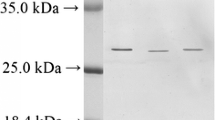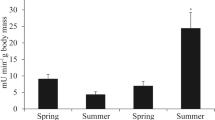Summary
The apparent Michaelis constants of crude trypsin preparations of three fishes with stomach, four Cyprinidae, five amphibians and three reptiles were determined at 15°C, 30°C and at the temperature preferendum of each species. The affinity of the sum of all trypsin isozymes of a given species for DL-BAPA was correlated with the temperature preferenda (Tp) of the species. The affinity of trypsins in vertebrates with a high Tp is, as a rule, lower than in species with a low Tp. However, the agastric cyprinids possess trypsins with a much higher affinity than those of other vertebrates. Within species the relationship between Km(app) and experimental temperature is different in different groups of vertebrates. In the terrestrial species there is a tendency for each species to have the lowest value of Km(app) in its preferred range of temperature. On the other hand, in fish, and in tadpoles ofRana temporaria, Km is independent of experimental temperature over a wide range.
Similar content being viewed by others
References
Barrington, E. J. W.: Gastric digestion in the lower vertebrates. Biol. Rev. Cambr. Phil. Soc.17, 1–26 (1942)
Béchet, J. J., Yon, J.: Mise en évidence d'un effet allostérique lors de l'hydrolyse du p-toluène sulfonyl-L-arginyl-methyl ester par la trypsine. Biochim. biophys. Acta (Amst.)89, 117–126 (1964)
Bogert, C. M.: Relative abundance, habitats and normal thermal levels of some Virginia Salamanders. Ecology33, 16–30 (1952)
Cunningham, L.: The structure and mechanism of action of proteolytic enzymes. Comprehens. Biochem.16, 85–188 (1965)
Erlanger, B. F., Kolowsky, N., Cohen, W.: The preparation and properties of two new chromogenic substrates of trypsin. Arch. Biochem. Biophys.95, 271–278 (1961)
Feder, M. E., Pough, H.: Temperature selection by the red-backed salamander,Plethodon c. cinereus (Caudata: Plethodontide). Comp. Biochem. Physiol.50A, 91–98 (1975)
Ferguson, R. G.: The preferred temperature of fish and their midsummer distribution in temperate lakes and streams. J. Fish. Res. Bd. Canada15, 607–624 (1958)
Fry, F. E. J.: Effects of the environment on animal activity. Univ. Toronto stud. Biol. Ser. No. 55 (Pub. Ont. Fish. Res. Lab. No. 68, 62 pp.) (1947)
Garside, E. T., Tait, J. S.: Preferred temperature of rainbow trout (Salmo gairdneri R.) and its unusual relationship to acclimation temperature. Canad. J. Zool.36, 563–567 (1958)
Hazel, J., Prosser, C. L.: Interpretation of inverse acclimation to temperature. Z. vergl. Physiol.67, 217–228 (1970)
Herter, K.: Über Vorzugstemperaturen von Reptilien. Z. vergl. Physiol.28, 105–141 (1940)
Hochachka, P. W.: Basic strategies and mechanisms of enzyme adaptation to temperature. In: Effects of temperature on ectothermic organisms (ed. W. Wieser), p. 69–81. Berlin-Heidelberg-New York: Springer 1973
Hochachka, P. W., Somero, G. N.: Strategies of biochemical adaptation. Philadelphia: W. B. Saunders 1973
Hofer, R.: Einfluß von Temperatur, Licht und Jahreszeit auf Verdauung und Atmung zweier Froscharten:Rana ridibunda (bzw.Rana esculenta) undRana temporaria. Diss. Phil. Fak., Univ. Innsbruck (1971)
Hofer, R.: Einfluß von Temperatur, Photoperiode und Jahreszeit auf Verdauung und Atmung zweier Froscharten:Rana ridibunda (bzw.Rana esculenta) undRana temporaria. Zool. Jb. Physiol.76, 507–530 (1972)
Jany, K. D.: Isolierung und Charakterisierung von Serin-Endopeptidasen des magenlosen FischesCarassius auratus gibelio. Diss. Univ. Heidelberg (1972)
Katzenellenbogen, B. S., Kafatos, F. C.: Proteinases of silkmoth moulting fluid: physical and catalytical properties. J. Insect Physiol.17, 775–800 (1971)
Kauri, H.: Die Rassenbildung bei europäischen Rana-Arten und die Gültigkeit der Klimaregeln. Ann. Soc. tartun. res. nat. investig. constit.2, pp. 172 (1959)
Kleine, R.: Vorkommen und Eigenschaften der proteolytischen Enzyme des Magensaftes und der Mitteldarmdrüse des FlußkrebsesAstacus astacus undCambarus affinis—II. Endopeptidasen. Z. vergl. Physiol.55, 51–69 (1967)
Kleine, R., Stangenberg, P.: Isolierung und Charakterisierung der beiden Trypsin-Isoenzyme des amerikanischen FlußkrebsesCambarus affinis. Hoppe-Seylers Z. physiol. Chem.355, 114–124 (1974)
Knapp, W.: Die jahreszeitliche Steuerung der Atmung in Abhängigkeit von Akklimationstemperatur und Experimentaltemperature beiTriturus alpestris Laur. undSalamandra atra Laur. (Amphibia). Oecologia (Berl.)15, 353–374 (1974)
Licht, P.: Effects of temperature on heart rates of lizards during rest and activity. Physiol. Zool.38, 129–137 (1965)
Lutfi, M.: Das thermotaktische Verhalten einiger Reptilien. Diss. Berlin (1936)
News, H.: Über die Temperaturadaptation der Sekretion von Verdauungsfermenten und deren Hitzeresistenz. Z. vergl. Physiol.40, 356–362 (1957)
Miller, J. W., Kramer, K. J., Law, J. H.: Isolation and partial characterization of the larval midgut trypsin from the tobacco hornworm,Manduca sexta (Lepidoptera: Sphingidae). Comp. Biochem. Physiol.48B, 117–129 (1974)
Neurath, H., Schwert, G. W.: The mode of action of the crystalline pancreatic proteolytic enzymes. Chem. Revs.46, 69–153 (1950)
Nilsson, A., Fänge, R.: Digestive proteases in the holocephalian fishChimaera monstrosa. Comp. Biochem. Physiol.31, 147–165 (1969)
Norris, K. S.: The function of temperature in the ecology of the percoid fishGiralla nigricans. Ecol. Monogr.33, 23–62 (1963)
Owen, T. G., Wiggs, A. J.: Thermal compensation in the stomach of the brook trout (Salvelinus fontinalis). Comp. Biochem. Physiol.40B, 465–473 (1971)
Pfleiderer, G., Zwilling, R.: Über eine im physiologischen Bereich native Proteine hydrolysierende Endopeptidase aus dem Darm vonTenebrio molitor. Biochem. Z.344, 127–140 (1966)
Pfleiderer, G., Zwilling, R., Sonneborn, H. H.: Eine Protease vom Molekulargewicht 11000 und eine trypsinähnliche Fraktion ausAstacus fluviatilis. Hoppe-Seylers Z. physiol. Chem.348, 1319–1331 (1967)
Pfleiderer, G., Zwilling, R.: Die molekulare Evolution proteolytischer Enzyme. Naturwissenschaften59, 396–405 (1972)
Pitt, T. K., Garside, E. T., Hepburn, R. L.: Temperature selection of the carp (Cyprinus carpio). Canad. J. Zool.34, 555–557 (1956)
Precht, H., Christophersen, J., Hensel, H., Larcher, W.: Temperature and life. Berlin-Heidelberg-New York: Springer 1973
Prosser, C. L.: Physiological adaptation. Washington: Amer. Phys. Soc. 1958
Prosser, C. L.: Comparative animal physiology. Philadelphia-London-Toronto: W. B. Saunders 1973
Reichling, H.: Transpiration und Vorzugstemperatur mitteleuropäischer Reptilien und Amphibien. Zool. Jahrb. Allg. Zool.67, 1–64 (1957)
Rinderknecht, H., Geokas, M. C.: Anionic and cationic trypsinogens (trypsins) in mammalian pancreas. Enzyme14, 116–130 (1972/73)
Rosenthal, G. M.: The role of moisture and temperature in the local distribution of the plethodontid salamanderAneides lugubris. Univ. Calif. Publ. Zool.54, 371–420 (1957)
Rühmekorf, E.: Beiträge zur Ökologie mitteleuropäischer Salientia II. Temperaturwahl der Larven. Z. Morph. Ökolog. Tiere47, 20–36 (1958)
Schlieper, C.: Genetic and nongenetic cellular resistance adaptation in marine invertebrates. Helgoländer wiss. Meeresunters.14, 482–502 (1966)
Schoener, T. W.: Nonsynchronous spatial overlap of lizards in patchy habits. Ecology51, 408–418 (1970)
Smit, H.: Influence of temperature on the rate of gastric juice secretion in the brown bullheadIctalurus nebulosus. Comp. Biochem. Physiol.21, 125–132 (1967)
Strübing, H.: Über Vorzugstemperaturen von Amphibien. Z. Morph. Ökol. Tiere43, 357–386 (1954)
Trautschold, I.: Habilitationsschrift, Med. Fak. Univ. München (1965)
Tuppy, H., Wiesbauer, U., Wintersberger, E.: Aminosäure-p-nitroanilide als Substrat für Aminopeptidasen und andere proteolytische Fermente. Hoppe-Seylers Z. physiol. Chem.329, 278–288 (1962)
Varley, M. E.: British freshwater fishes. Fishing News (Books) London (1967)
Zahn, M.: Die Vorzugstemperaturen zweier Cypriniden und eines Cyprinodonten und die Adaptationstypen der Vorzugstemperaturen bei Fischen. Zool. Beitr., N. S.7, 13–25 (1962)
Zahn, M.: Jahreszeitliche Veränderungen der Vorzugstemperaturen von Scholle und Bitterling. Zool. Anz., Suppl.27, 562–580 (1964)
Author information
Authors and Affiliations
Rights and permissions
About this article
Cite this article
Hofer, R., Ladurner, H., Gattringer, A. et al. Relationship between the temperature preferenda of fishes, amphibians and reptiles, and the substrate affinities of their trypsins. J Comp Physiol B 99, 345–355 (1975). https://doi.org/10.1007/BF00710375
Received:
Issue Date:
DOI: https://doi.org/10.1007/BF00710375




